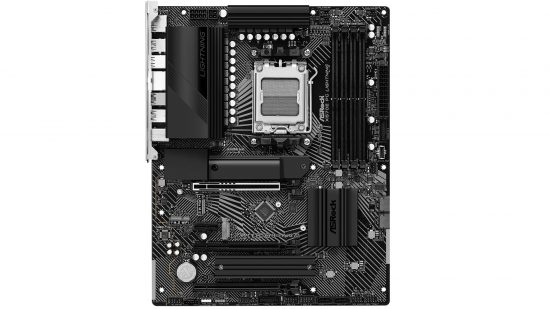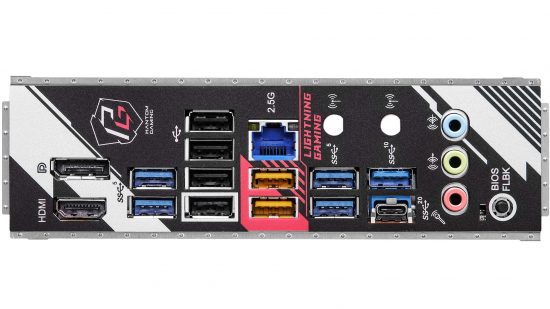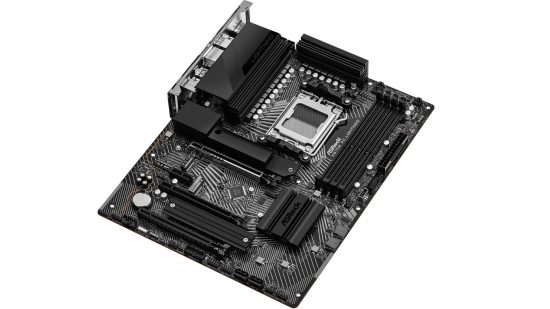Our Verdict
82%The ASRock X670E PG is proof that you don’t need to mug your wallet in order to afford a Socket AM5 motherboard.
If your hopes of owning a Ryzen 7000 Zen 4 system were dashed due to recent motherboard pricing leaks, the fact that some X670E motherboards won’t cost you more than $300 probably comes as moderately good news.
The ASRock X670E PG Lightning still costs more than we’d have paid for a premium offering a few years ago, but the $259 price is still much more accessible than the other first-gen Socket AM5 motherboards we’ve seen this month. The big question, though, is whether you lose anything major by opting for a cheaper board such as this one.
At Custom PC, we’ve been reviewing and overclocking the latest motherboards since we first launched in 2003, so we know exactly what to look for in terms of layout, features, performance, and overclocking abilities.
The heatsinks for the PG Lightning’s 14+2+1 phase power delivery are fairly beefy, but the one above the rear I/O panel fails to extend all the way to the integrated I/O shroud, meaning there’s a bunch of unsightly shiny silver ports visible next to the black heatsink.
The rest of the board looks very smart, though, with an attractive black-and-white patterned PCB, and black heatsinks. Thankfully, our IR probe revealed temperatures no higher than 57°C, so we’re confident this board has what it takes to handle AMD’s latest 16-core CPU, the Ryzen 9 7950X.

Sitting near the bottom of ASRock’s Socket AM5 motherboard stack, the ASRock X670E PG Lightning has shed a few features to get there, such as only sporting Realtek ALC897 audio codec and a trio of audio outputs excluding an optical output, plus there’s no Wi-Fi included either.
There is 2.5Gbps Ethernet, though, and amazingly, ASRock has managed to shoehorn four M.2 ports into the equation, two of which have heatsinks, and the top M.2 port even offers support for a PCIe 5 SSD as well. There are four SATA 6Gbps ports as well, so you have plenty of storage options, and there’s a fairly typical total of six 4-pin fan headers as well.
Meanwhile, ASRock’s software and EFI offer reasonable control over your fans, but it’s not as granular or appealing as the fan control options from the competition, while the EFI in general feels less attractive and a bit dated, even if we approve of the simple layout.

There’s also PCIe 5 support to be found on the top 16x PCIe slot, with two further 16x PCIe 4 slots and a 1x PCIe 4 slot as well, with these additional slots actually offering more bandwidth overall than the slots on the more expensive X670E Steel Legend. The rear I/O panel hasn’t been neglected either, and while there’s no Wi-Fi, ASRock includes mounts here for aerials, and there’s a dedicated M.2 port to add your own Wi-Fi module.
In addition, this panel offers an impressive tally of 11 Type-A USB ports, four of which are USB 2, one is USB 3.2 Gen 2 and the rest are USB 3. Not surprisingly, the lone Type-C port lacks Thunderbolt and USB 4 support, but both it and the Type-C header on the PCB are USB 3.2 Gen 2×2-capable. There’s also a USB BIOS flashback button, plus both HDMI and DisplayPort graphics outputs.
ASRock X670E PG Lightning performance
The X670E PG Lightning’s top M.2 port was able to return read and write speeds of 7,322MB/sec and 6,842MB/sec respectively with our PCIe 4 SSD, although the SSD temperature did peak at 68°C at the end of our load test, so you’d be well advised to have a case fan blowing across the motherboard, in order to keep temperatures in check under sustained loads.
Despite only having Realtek ALC897 audio, the PG Lightning returned some half-decent numbers in RightMark Audio Analyzer software, with a dynamic range of 96dBA, noise level of 95.8dBA and THD of 0.0015 percent – it’s not outstanding audio quality, but it’s fine for most people’s needs.
Power consumption was noticeably lower than other boards we’ve tested as well, with the X670E Taichi drawing 376W under load compared to 336W for the X670E PG Lightning. However, this could be down to BIOS versions, as a new one had just landed for the latter just before we wrote this review.
The performance was fine though. The PG Lightning’s multi-threaded Cinebench score of 38,502 was slightly ahead of the X670 Taichi, while the RealBench system score of 491,557 was just a fraction behind that of the other boards we tested this month. Overall, in terms of basic performance, there doesn’t seem to be any benefit from spending more money on a Socket AM5 motherboard, even if you’re using a Ryzen 9 7950X.
ASRock X670E PG Lightning pros and cons
Pros
- Copes fine with Ryzen 9 7950X
- PCIe 5 M.2 support
- 11 Type-A USB ports
- Non-ridiculous price
Cons
- No onboard overclocking and testing tools
- Basic EFI
- Mediocre M.2 temperatures
- Entry-level audio
ASRock X670E PG Lightning specs
The ASRock X670E PG Lightning specs list is:
| Dimensions (mm) | 305 x 244 |
| Chipset | AMD X670E |
| CPU socket | AMD Socket AM5 |
| Memory support | 4 slots: max 128GB DDR5 (up to 6600MHz) |
| Sound | Realtek ALC897 |
| Expansion slots | One 16x PCIe 5, two 16x PCIe 4, one 1x PCIe 4 |
| Networking | Realtek 2.5Gbps LAN |
| Cooling | Six 4-pin fan headers, VRM heatsinks, M.2 heatsinks |
| Ports | 4 x SATA 6Gbps, 1 x M.2 PCIe 5, 2 x M.2 PCIe 4, 1 x M.2 PCIe 3, 1 x USB 3.2 Gen 2 2×2 Type-C, 1 x USB 3.2 Gen2 Type-A, 6 x USB 3 Type-A, 4 x USB 2, 1 x USB 3.2 Gen 2×2 Type-C header, 1 x audio out, 1 x mic, 1 x line-in |
ASRock X670E PG Lightning price
The price of the ASRock X670E PG Lightning is higher than equivalent previous-generation motherboards, but it makes for an affordable entry point for an AMD Socket AM5 system.
Price: Expect to pay $279 USD / £289 GBP
ASRock X670E PG Lightning review conclusion
It’s clear that aside from overclocking, which we haven’t had time to explore with AMD’s 170W-TDP CPUs much yet, there isn’t much benefit from spending upwards of $400 on a Socket AM5 motherboard.
The ASRock X670E PG Lightning has some quirks, such as its strange-looking I/O shroud, mediocre M.2 temperatures and basic EFI, but it otherwise performed flawlessly with AMD’s Ryzen 9 7950X at stock speed, offering performance that was on par with more expensive boards.
Its audio codec isn’t the best, but it’s still fine for most people’s needs, and its PCIe 5 M.2 and 16x slots add an element of futureproofing too. It’s a shame there are no onboard overclocking and testing tools, or Wi-Fi, which we’d normally expect ASRock to include at this price, but all new computer hardware is increasing in price at the moment. Whatever Zen 4 CPU you buy, though, the ASRock X670E PG Lightning has what it takes to accommodate it.
If this motherboard isn’t right for your needs, check out our full guide to the best AM5 motherboard for more options at a range of prices.
